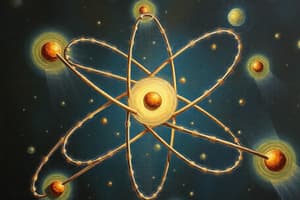Podcast
Questions and Answers
What did William Crookes' development of the cathode ray tube primarily demonstrate?
What did William Crookes' development of the cathode ray tube primarily demonstrate?
- Cathode rays are negatively charged particles. (correct)
- Electrons are part of the atomic structure.
- Atoms are indivisible entities.
- Protons can be observed in rays.
J.J. Thomson's plum pudding model was significant because it proposed which of the following?
J.J. Thomson's plum pudding model was significant because it proposed which of the following?
- Protons exist independently in the atom.
- Atoms are mostly empty space.
- Atoms contain a dense nucleus.
- Electrons are embedded in a positively charged mass. (correct)
What did Robert Millikan's oil drop experiment primarily determine?
What did Robert Millikan's oil drop experiment primarily determine?
- The mass of protons.
- The charge of an electron. (correct)
- The existence of neutrons.
- The size of the atomic nucleus.
Which discovery did Eugen Goldstein contribute to atomic theory?
Which discovery did Eugen Goldstein contribute to atomic theory?
What was a key conclusion of Rutherford's gold foil experiment?
What was a key conclusion of Rutherford's gold foil experiment?
In the diagrams of atomic models, which of the following represents Thomson's model?
In the diagrams of atomic models, which of the following represents Thomson's model?
James Chadwick is credited with the discovery of which subatomic particle?
James Chadwick is credited with the discovery of which subatomic particle?
What characteristic does a neutron have compared to a proton?
What characteristic does a neutron have compared to a proton?
Flashcards are hidden until you start studying
Study Notes
Cathode Ray Tube
- Developed by William Crookes in 1879
- Cathode rays impart a negative charge to objects they strike
- Cathode rays are deflected by electric and magnetic fields
Thomson's Plum Pudding Atom Model
- Developed by J.J. Thompson in 1897
- Thomson discovered electrons
- Electrons are embedded within a positively charged "pudding"
Oil Drop Experiment
- Developed by Robert Millikan
- Millikan determined the charge of an electron
- Millikan calculated the mass of an electron
Canal Rays
- Developed by Eugen Goldstein
- Canal rays consist of positive ions, which led to the discovery of protons
- Canal rays are composed of positively charged particles
Neutron Discovery
- Developed by James Chadwick
- Chadwick discovered neutrons
- Neutrons are subatomic particles with no charge and mass similar to protons
Rutherford's Gold Foil Experiment
- Developed by Ernest Rutherford
- Rutherford determined that the atom's positive charge and most of its mass are concentrated in a very small, dense nucleus
- Rutherford used alpha particles
- Rutherford tested scattering of alpha particles off a thin sheet of gold foil
Diagrams
- A diagram shows Rutherford's atomic model with a central nucleus containing protons and neutrons
- Electrons are shown orbiting the nucleus
- A diagram shows Thomson's plum pudding model with electrons embedded in a sphere of positive charge
Studying That Suits You
Use AI to generate personalized quizzes and flashcards to suit your learning preferences.




